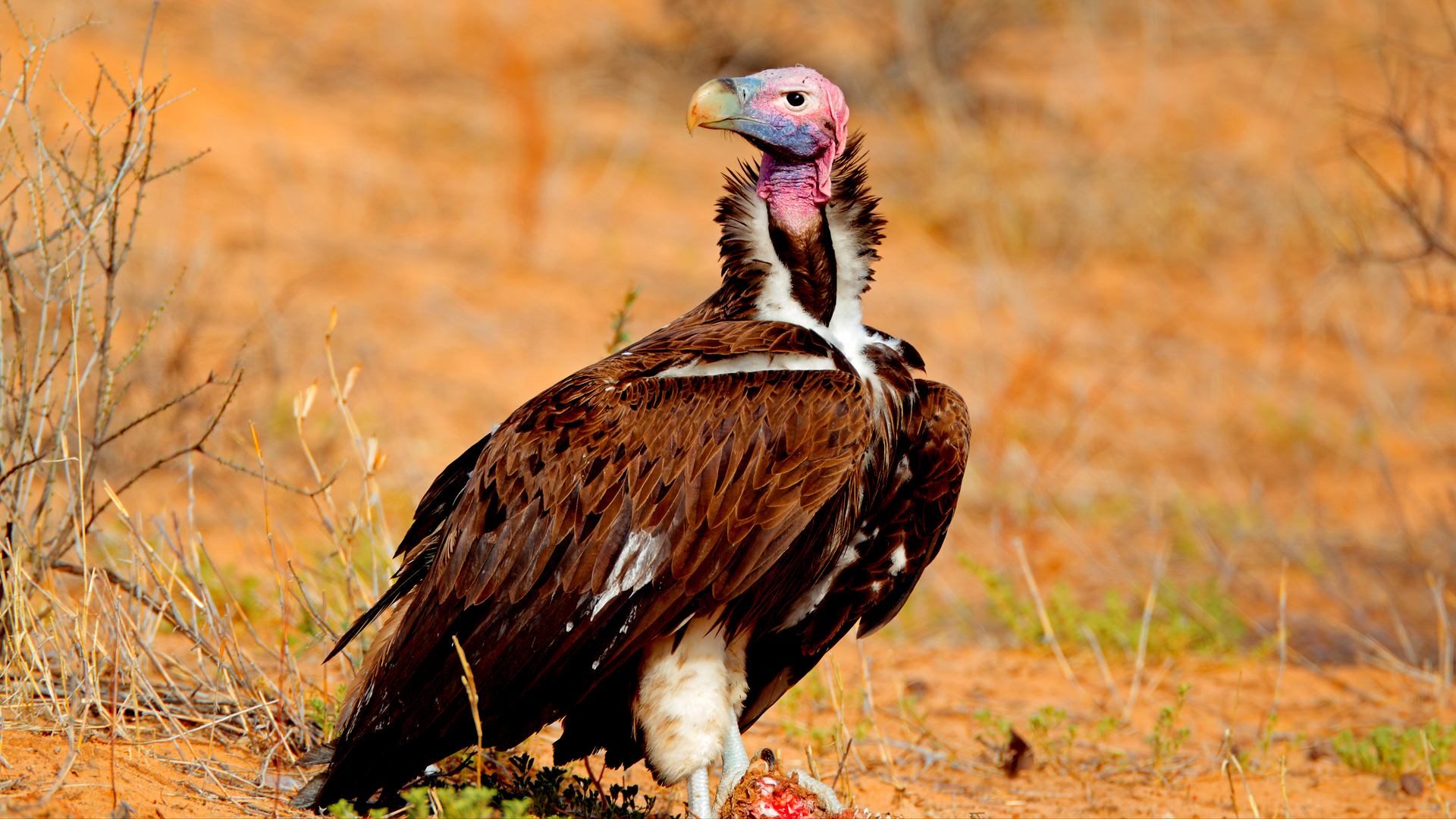- Home
- Conservancy
- Lappet faced vulture
WHERE TO SEE Lappet faced vulture
Description
The lappet-faced vulture is a huge species, ranking as the longest and largest winged vulture in its range behind the closely related cinereous vulture, although some co-occurring Gyps vultures tend to be heavier on average, especially the Cape vulture and Eurasian griffon. This species measures around 95–115 cm (37–45 in) in body length, with a wingspan of 2.5–2.9 m (8.2–9.5 ft). Among the standard measurements, the wing chord is 71.5–82.5 cm (28.1–32.5 in), the tail is 33–36 cm (13–14 in) and the tarsus is 12.2–15 cm (4.8–5.9 in). The bill, at up to 10 cm (3.9 in) long and 5 cm (2.0 in) deep, ranks as one of the largest of any accipitrid, although a reported culmen length of 7.2 cm (2.8 in) is slightly less than the culmen length of the cinereous vulture. Wild vultures, of the subspecies T. t. tracheliotus, range from 4.4 to 9.4 kg (9.7 to 20.7 lb) and, in East Africa, average only 6.2 kg (14 lb). On the other hand, captive vultures of the larger T. t. negevensis subspecies, weighed 6.5–9.2 kg (14–20 lb) in males and 10.5–13.6 kg (23–30 lb) in females.
Overall, the lappet-faced vulture is blackish above with a strongly contrasting white thigh feathers. The black feathers on the back of African vultures are lined with brown, while Arabian birds are dark brown rather than black above. The underside can range from pure white to buff-brown. Like many vultures, it has a bald head. The head coloration can range from reddish in southern Africa to dull pink in more northern Africa to pink on the back of the head and gray on the front in the Arabian Peninsula.
The combination of the colorful head and fleshy folds on the side of it are distinctive. The bald head of the lappet-faced vulture is advantageous, because a feathered head would become spattered with blood and other fluids, and thus be difficult to keep clean. While flying, lappet-faced vultures have large, broad wings held with the front edges held parallel and slightly pointed, serrated-looking wingtips. Compared to the somewhat similarly marked hooded vulture, it is considerably larger with a more massive bill and can only be confused at a great distance. The Gyps vultures are generally much paler, with less white lining the wings and more bulging secondaries. The cinereous vulture (which may overlap in range in the Arabian area) has a similar body shape but is all dark, with no contrasting plumage
Fun Facts
The lappet-faced vulture is a scavenging bird, feeding mostly from animal carcasses, which it finds by sight or by watching other vultures. More so than many other African vultures, they often find carrion on their own and start tearing through the skin. They are the most powerful and aggressive of the African vultures, and other vultures will usually cede a carcass to the lappet-faced vulture if it decides to assert itself. This is often beneficial to the less powerful vultures because the Lappet-face can tear through the tough hides and knotty muscles of large mammals that the others cannot penetrate, although hyenas are even more efficient in this regard (if more voracious eaters).
However, lappet-faced vultures frequently hang around the edges of the throngs at large carcasses, waiting until the other vultures are done, to feed on remnant skin, tendons and other coarse tissues that the others will not eat. Big game animals, up to the size of elephants, are preferred as carrion, since they provide the most subsistence at a sitting. A full crop can contain up to 1.5 kg (3.3 lb) of meat. Perhaps more than any other true vulture, lappet-faced vultures have been recorded as regularly feeding on freshly killed smaller mammals, birds and reptiles. Some of these are probably road-kills or are pirated from eagles or other raptors but they are also believed to occasionally attack live animals, especially young and weak animals and the nests and young of other birds. Flamingo colonies (including eggs, young and adults), young impalas and guineafowl have reportedly been predated.
They are believed to still-hunt from an elevated perch and then drop on their prey, stunning them with the impact and tearing them apart with their strong bills. Most remains found at nests are from small animals possibly caught alive
